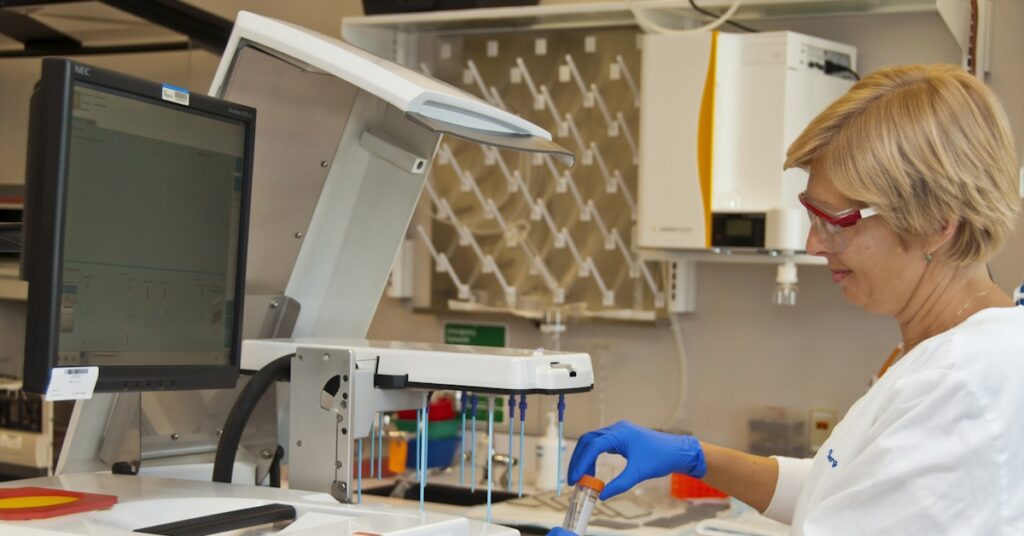Is your app down again?
When your application fails, the pressure is on to find the root cause immediately, before it impacts more users and escalates.
The real challenge is navigating complex, distributed systems where the source of a critical error can be almost impossible to trace manually.
This isn’t just an inconvenience; it’s a frustrating cycle of reactive fire-fighting. It keeps your best engineers from focusing on innovation and proactive improvements.
The right APM tool changes this dynamic entirely. It helps you cut through the noise to find the exact line of failing code.
In this guide, I’ll show you the best application performance monitoring tools. We’ll explore powerful solutions built to dramatically reduce your Mean Time to Resolution (MTTR).
You’ll discover how to get clear performance visibility, diagnose issues much faster, and keep your services reliable for your users.
Let’s get started.
Quick Summary:
| # | Software | Rating | Best For |
|---|---|---|---|
| 1 | Datadog → | Large hybrid cloud enterprises | |
| 2 | New Relic → | Mid-market SaaS companies | |
| 3 | Dynatrace → | Cloud-native enterprises | |
| 4 | AppDynamics → | Hybrid IT and DevOps teams | |
| 5 | Sentry → | Developer teams in fast-moving startups |
1. Datadog

Struggling with complex application performance monitoring?
Datadog provides end-to-end, simplified visibility into your stack’s health and performance, tackling the overwhelming options you face.
This integrated platform unifies monitoring across infrastructure, applications, and logs, offering a comprehensive view so you can track microservices performance without disruption. The result is a unified dashboard that cuts through conflicting vendor claims.
You need unified performance visibility.
Datadog excels at delivering end-to-end observability, providing tools like Application Performance Monitoring (APM), Universal Service Monitoring, and Continuous Profiler. This means you gain deep insights into your applications, helping you pinpoint root causes and reduce your Mean Time To Resolution. For your hybrid cloud infrastructure, Datadog offers Infrastructure Monitoring and Container Monitoring, allowing you to see inside any stack, any app, at any scale, anywhere. Additionally, its AI capabilities, including LLM Observability and AIOps features like Watchdog, assist in anomaly detection and optimizing model performance.
It’s about achieving clear, actionable insights.
Before diving deeper, you might find my analysis of marketing analytics tools helpful for understanding broader business insights.
Key features:
- Application Performance Monitoring (APM): Optimize and investigate application performance with end-to-end visibility, supporting complex microservices architectures.
- Infrastructure Monitoring: Gain deep insights into your infrastructure, including network, container, and serverless environments, perfect for hybrid cloud setups.
- Log Management: Analyze and explore logs for rapid troubleshooting, simplifying data correlation and reducing the time spent on problem identification.
Learn more about Datadog features, pricing, & alternatives →
Verdict: Datadog stands out as a strong contender for the best application performance monitoring tools, integrating observability, security, and AI capabilities. Its comprehensive suite addresses key pain points like hybrid cloud monitoring, microservices tracking, and real-time performance visibility, empowering your team to proactively resolve issues and align monitoring with business KPIs.
2. New Relic
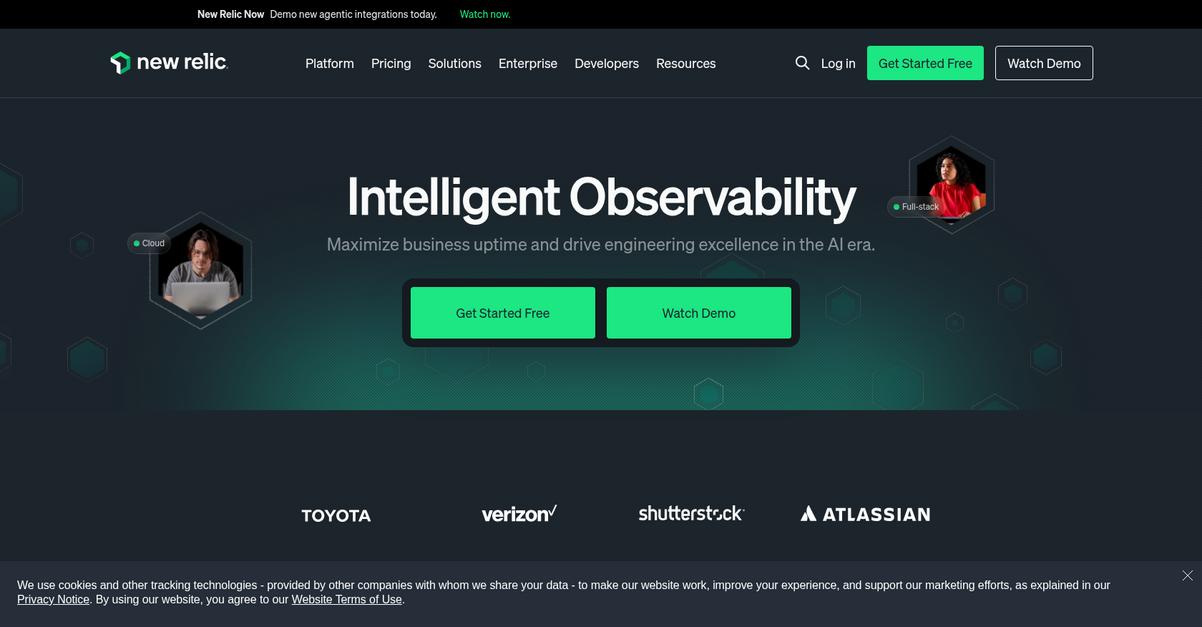
Struggling with complex APM tools?
New Relic offers intelligent observability for your full stack, helping you cut through the noise.
This means you can focus on the data and stack that matter most, swiftly identifying and resolving issues across your entire environment. It’s all about maximizing your business uptime.
Ready to simplify performance monitoring?
New Relic provides 50+ capabilities in one unified platform, addressing front-end, back-end, infrastructure, and even security vulnerabilities. You can achieve up to 5x faster issue resolution with intelligent transaction observability, seeing all the data that impacts your application performance. This comprehensive view spans APM, Browser, Mobile, and Kubernetes monitoring, ensuring no blind spots. Additionally, features like Alerts, Anomalies, and Dashboards give you real-time insights and proactive management tools. Plus, agentic AI integrations help automate busywork and enhance productivity, giving you more time for critical tasks.
Get unparalleled visibility.
If you’re also managing business finances, my article on best SaaS billing software covers predicting cash flow effectively.
Key features:
- Full-stack visibility: Monitor your entire environment, from front-end and back-end to infrastructure and logs, ensuring comprehensive coverage and eliminating blind spots.
- Intelligent transaction observability: Resolve issues up to 5x faster by focusing on the most critical data and transaction paths across your application stack.
- Flexible, usage-based pricing: Pay only for what you use, based on actual consumption, not peak usage, avoiding overages and providing predictable costs.
Learn more about New Relic features, pricing, & alternatives →
Verdict: New Relic stands out as one of the best application performance monitoring tools for mid-market SaaS companies due to its unified platform, which delivers full-stack observability and intelligent issue resolution. With its transparent, usage-based pricing and ability to consolidate over 50 capabilities, it provides significant value and helps reduce MTTR, empowering your engineering teams to deliver better experiences.
3. Dynatrace

Struggling with complex, hybrid cloud environments?
Dynatrace unifies observability and security for cloud-native and enterprise stacks.
This means you can transform complexity into your greatest asset through AI-powered insights.
Here’s how Dynatrace helps.
Dynatrace offers end-to-end infrastructure observability across multi-cloud environments. This allows you to automatically analyze, and innovate faster with their groundbreaking AI.
It provides APM, distributed tracing, and profiling, ensuring flawless digital experiences with real-user and synthetic monitoring. Additionally, its log analytics drive intelligent insights for troubleshooting and business processes. Plus, the platform supports over 715 technologies, integrating with all major cloud platforms.
The result is comprehensive visibility, reduced MTTR, and the ability to make better business decisions in real-time.
Before diving deeper, you might find my analysis of thermal analysis software helpful for improving design accuracy.
Key features:
- Infrastructure Observability: Delivers end-to-end visibility for modern multi-cloud environments, ensuring you understand your systems and data completely.
- Application Observability: Provides APM, distributed tracing, and profiling for both cloud-native and enterprise stacks, helping your team improve code and user satisfaction.
- Digital Experience: Offers real-user monitoring, synthetic monitoring, and session replays, allowing you to deliver flawless digital experiences and delight customers.
Learn more about Dynatrace features, pricing, & alternatives →
Verdict: Dynatrace is an excellent choice among the best Application Performance Monitoring tools for its AI-powered unified observability and security platform. Its capabilities in infrastructure and application monitoring, coupled with real-user experience insights, empower your team to innovate faster and make informed decisions, as evidenced by customers like BNZ accelerating growth with fewer issues.
4. AppDynamics
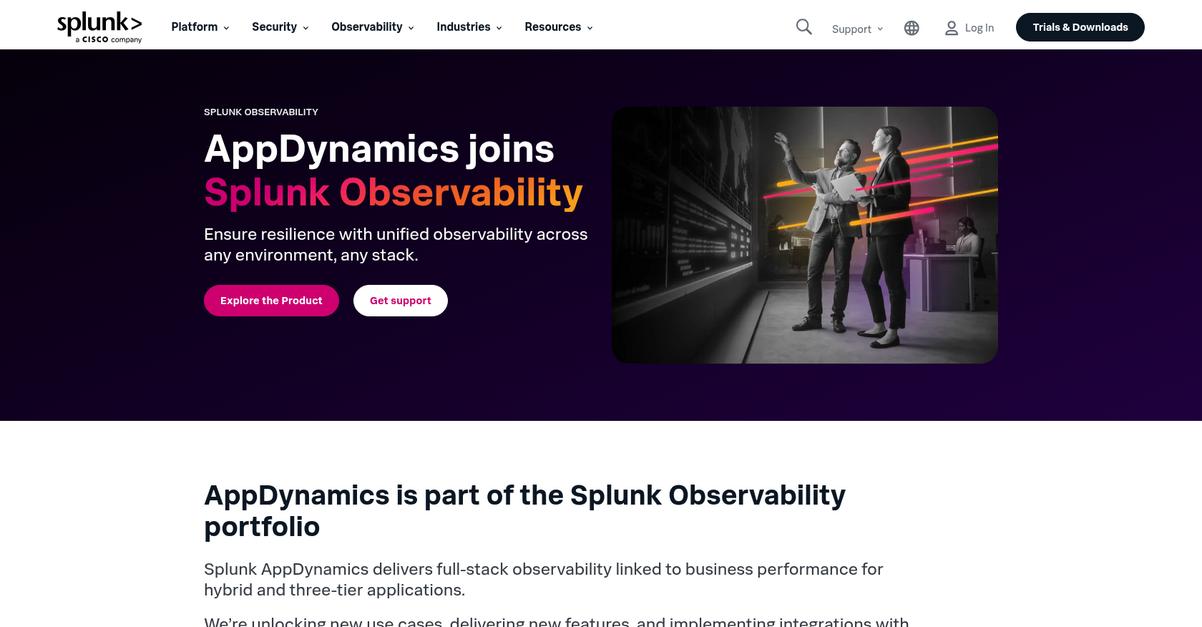
Struggling with application performance in your hybrid environment?
AppDynamics provides full-stack observability, ensuring you can detect, diagnose, and resolve issues quickly. This means you gain crucial visibility.
You can proactively discover problems, reducing time spent in war rooms and gaining better control of data and costs.
Here’s how AppDynamics helps your team.
AppDynamics offers unified visibility across any environment and stack, optimizing hybrid and on-prem application performance. Your team can see how issues anywhere affect your business, backed by features like application performance monitoring linked to business metrics. This includes every network, ISP, API, and service your applications use, along with application security tied to business risk. Additionally, AppDynamics supports monitoring for SAP solutions and digital experience monitoring, reducing alert noise and debugging microservices.
The result is smooth business operations.
Before diving deeper, you might find my analysis of application integration tools helpful.
Key features:
- Full-stack observability: Gain unified visibility across traditional and cloud-native applications, on-prem, private, and public clouds, plus owned and unowned networks.
- Business performance linkage: Connect application performance directly to business metrics, offering a clear view of how IT impacts your bottom line and user experience.
- AI-powered troubleshooting: Accelerate problem resolution across teams with AI capabilities that help analyze security infrastructure and application data for critical action items.
Learn more about AppDynamics features, pricing, & alternatives →
Verdict: AppDynamics excels as a top Application Performance Monitoring Tools for IT directors and DevOps engineers by offering robust full-stack observability for hybrid and three-tier applications. Its AI-powered insights streamline troubleshooting and resolution, integrating seamlessly with existing workflows and helping optimize cloud monitoring, making it a powerful choice.
5. Sentry
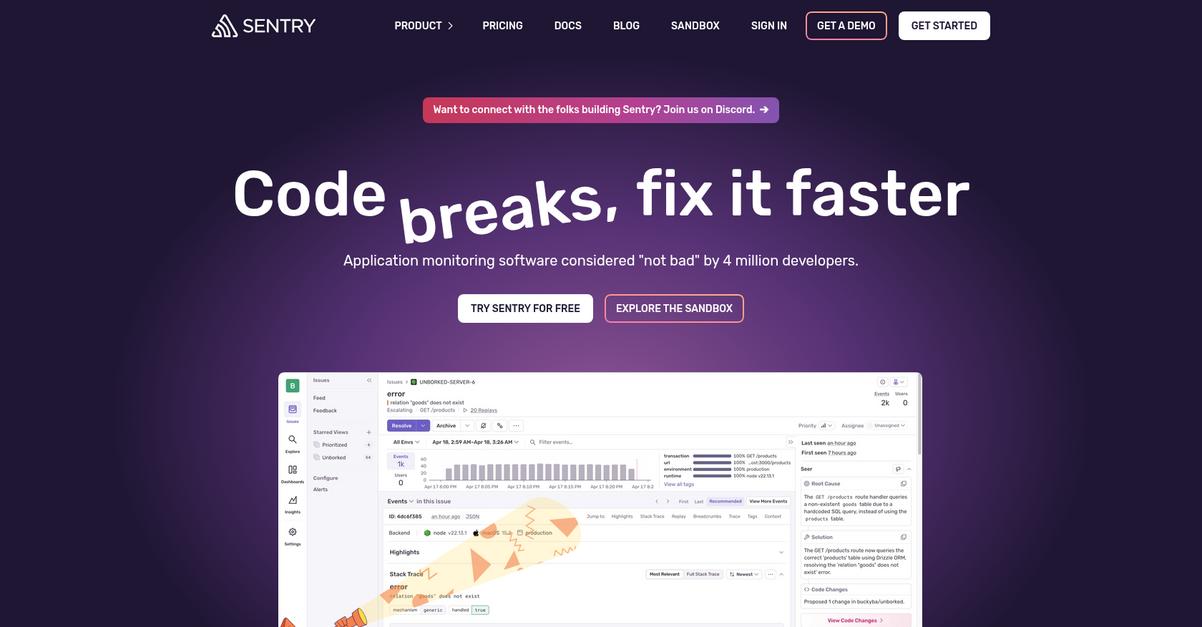
Struggling to find root causes quickly?
Sentry’s Error Monitoring and Tracing capabilities allow you to pinpoint issues fast, cutting through the noise of complex systems.
This means you can triage issues based on impacted customers, focusing your efforts on what truly matters to your users and your business’s bottom line.
How do you tackle those elusive production issues?
Sentry makes fixing problems easier by giving you complete visibility. Its Tracing feature lets you see the full, end-to-end data path across your distributed system, revealing the exact origin of an issue.
Plus, you can automatically detect and trace slow transactions, ensuring you quickly identify and resolve performance bottlenecks. Additionally, Session Replay shows you exactly what users experience, including console output and network calls, and even highlights dead or rage clicks. This visual context, combined with Code Coverage insights in your pull requests, helps you catch issues earlier and streamline review cycles, keeping your development pipeline flowing smoothly without escalating problems.
Resolve critical issues before they impact users.
While focusing on application performance, understanding the best application server software can further optimize your setup.
Key features:
- Error Monitoring: Quickly identifies, debugs, and resolves application errors by providing full context down to the broken line of code, helping your team prioritize issues based on user impact.
- Distributed Tracing: Pinpoints the exact origin of issues by visualizing the complete end-to-end data flow through your distributed system, enabling rapid resolution of slow transactions.
- Session Replay & Code Coverage: Offers visual debugging context of user interactions and provides early test coverage insights directly within your PR workflow, shortening review cycles and preventing production issues.
Learn more about Sentry features, pricing, & alternatives →
Verdict: Sentry is an excellent choice for teams seeking the best Application Performance Monitoring tools, offering robust capabilities like error monitoring and distributed tracing. Its ability to provide deep code-level insights, automate alerts, and offer visual session replays means you can quickly diagnose and resolve problems, ensuring your team ships without delays, just like Disney+ maintains high-quality service.
6. ManageEngine
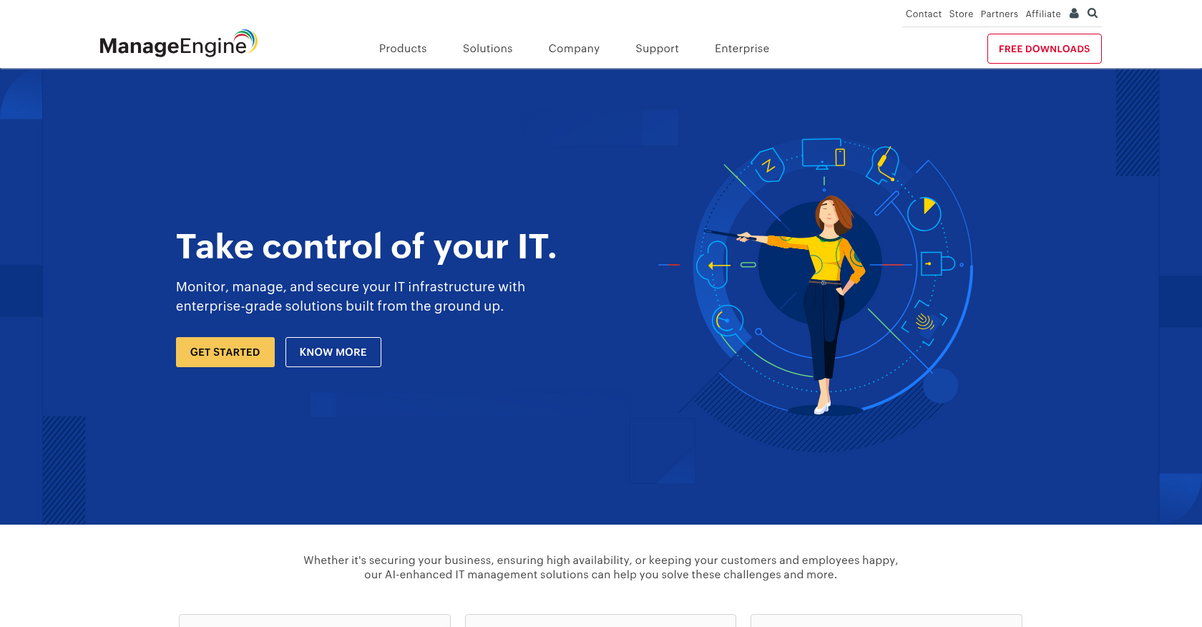
Struggling to gain real-time visibility into your applications?
ManageEngine offers IT Operations Management and Observability, designed to monitor and manage your network, servers, and applications effectively. This means you can keep your customers and employees happy by ensuring high availability.
Their AI-enhanced IT management solutions help you resolve challenges like securing your business and maintaining uptime. This leads to eliminating service disruptions and maximizing IT visibility.
Here’s how you can gain control.
ManageEngine helps you scale your IT to support multi-cloud and hybrid infrastructures through their Cloud Solutions. This comprehensive approach means you can streamline operations and reduce decision paralysis.
For instance, their IT Operations Management and Observability capabilities provide AIOps and DEM, allowing you to monitor applications and infrastructure with deep insights. Additionally, the Advanced IT Analytics solution offers unified IT analytics and AI-powered insights for IT data correlation and capacity planning. This comprehensive suite ensures you can proactively identify and resolve performance bottlenecks, ensuring your systems are always running smoothly and efficiently.
The result is better application performance and reduced MTTR.
While we’re discussing optimal system performance, understanding architecture design software is equally important for building robust systems from the ground up.
Key features:
- Unified IT Operations and Observability: Monitor and manage networks, servers, and applications, providing deep visibility across your entire IT infrastructure.
- AI-Enhanced IT Management: Utilize AI-powered insights and AIOps capabilities to automate tasks, predict issues, and gain actionable intelligence for smarter decision-making.
- Cloud Solutions for Hybrid IT: Support multi-cloud and hybrid environments, ensuring scalability and seamless performance monitoring across diverse IT landscapes.
Learn more about ManageEngine features, pricing, & alternatives →
Verdict: ManageEngine stands out as one of the best Application Performance Monitoring Tools for IT directors and DevOps engineers seeking robust observability. Its ability to monitor applications, infrastructure, and networks, combined with AI-enhanced insights and support for hybrid cloud, helps you achieve real-time visibility and reduce MTTR effectively.
Conclusion
Tired of constant performance fire-drills?
I understand. Choosing the right APM tool feels overwhelming. So many options make it hard to find one that fits your complex stack.
The right tool changes everything. Implementing advanced APM reduces mean time to resolution by an average of 50%. That’s half the time spent on emergencies, giving your engineers more time back to innovate.
So what is my top recommendation?
After my extensive review, Datadog is the clear winner. It provides a unified view that cuts through the complexity of modern, distributed systems.
Its powerful observability helps you track microservices and pinpoint root causes without disrupting workflows. It is one of the best application performance monitoring tools available today.
Beyond monitoring performance, making sense of your data is crucial for actionable insights. My guide on data discovery tools provides valuable perspectives.
I strongly recommend you see it in action. Start a free trial of Datadog and experience the clarity it brings to your engineering team.
You’ll resolve critical issues much faster.






